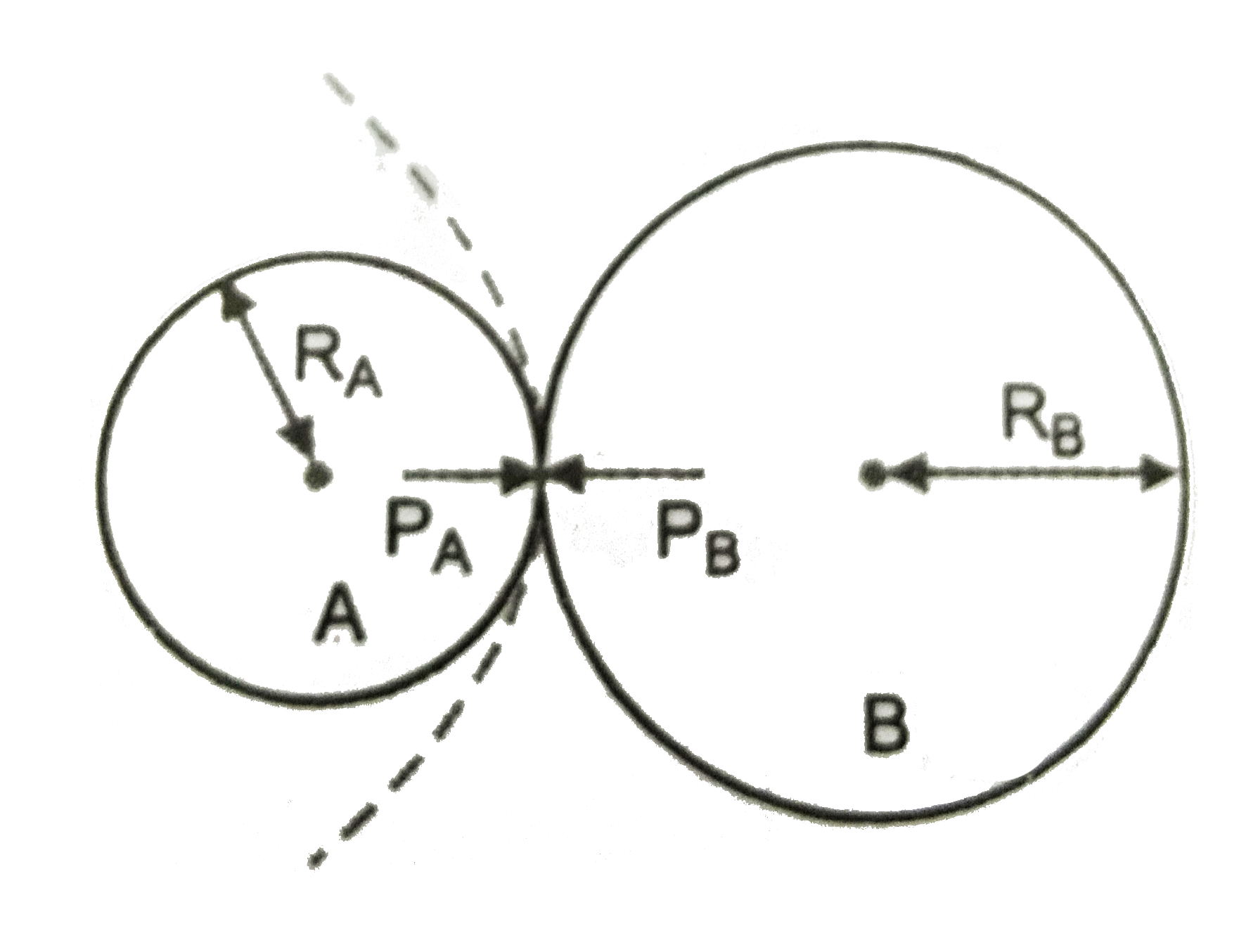Two separate air bubbles (radii 0.002cm and 0.004) formed of the same liquid (surface tension 0.07N/m) come together to form a double bubble. Find the radius and the sense of curvature of the internal film surface common to both the bubbles.
Let RAandRB be the radii of cuvarture of two air bubbles A and B. Let R be the radius of curvature of common surface when two bubbles a and B come together,

The excases presure in bubbles A, PA=4S/RA and the excess pressrue in bubble B, PB=4S/RB As R is the radius of curvature of the common interface, therefore, PA−PB=4S/R.
or 4SRA−SRB=4SRor1RA−1RB=1R
or R=RARBRB−RA=0.002×0.0040.004−0.002=0.004m We know that the excess pressure is more towards concave surface and is inversely proportional to radius of the bubble, therefore the concave surface bubble as shown by dotted. curve.
Topper's Solved these Questions
- BOOK - PRADEEPCHAPTER - PROPERTIES OF BULK MATTEREXERCISE - Value Based Question5videos
PROPERTIES OF BULK MATTER
- BOOK - PRADEEPCHAPTER - PROPERTIES OF BULK MATTEREXERCISE - Test Your Grip A10videos
PROPERTIES OF BULK MATTER
- BOOK - PRADEEPCHAPTER - PROPERTIES OF BULK MATTEREXERCISE - NCERT Questions73videos
PROPERTIES OF BULK MATTER
- BOOK - PRADEEPCHAPTER - PHYSICAL WORLD AND MEASUREMENTEXERCISE - Competiton Focus Jee Medical Entrance18videos
PHYSICAL WORLD AND MEASUREMENT
- BOOK - PRADEEPCHAPTER - RAY OPTICSEXERCISE - Problem For Practice(a)25videos
RAY OPTICS
Similar Questions
Two separate air bubble (radii 0.002cm and 0.004) formed of the same liqid (surface tension 0.07N/m) come together to form a double bubble. Find the radius and the sence of curvature of the internal film surface common to both the bubbles.
View SolutionTwo air bubbles are formed in water (surface tension 0.72 N/m). The bubbles come together to form a bigger bubble. What will be radius and sense of curvature of common surface of that bubble? The radii of bubbles are 0.003 m and 0.005 m.
View Solution
Knowledge Check
- Question 1 - Select One
Two seperate soap bubbles of radii 3×10−3 m and 2×10−3 m respectively, formed of same liquid (surface tension 6.5×10−2 N/m) come together to form a double bubble. The radius of interface of doubl bubble is
A6×10−3 mB4×10−3 mC1.5×10−3 mD0.66×10−3 m
Two soap bubbles of radii 2 cm and 4 cm join to form a double bubble in air, then radius of. curvature of interface is
View SolutionTwo air bubbles of radii 0.002 m and 0.004 m of same liquid come together to form a single bubble under isothermal condition. Find the radius of the buble formed. Given surface tension of liquid is 0.072Nm−1
View SolutionTwo soap bubbles of radius r1 and r2 combine. Find radius of curvature of the common surface separating them.
 View Solution
View SolutionWhen two soap bubbles of radii a and b (b>a) coalesce, the radius of curvature of common surface is :
View SolutionA spherical soap bubble of radius 2 cm attached to the outside of a spherical bubble of radius 4 cm. Find the radius of curvature of the common surface.
View SolutionTwo soap bubbles of radii 2 cm and 5 cm coalesce under isothermal condition in vaccum, to form a bigger bubble. Find the radius of new bubble.
View SolutionTwo identical soap bubbles each of radius r and of the same surface tension T combine to form a new soap bubble of radius R. The two bubbles contain air at the same temperature. If the atmospheric pressure is p0 then find the surface tension T of the soap solution in terms of p0, r and R. Assume process is isothermal.
View Solution

